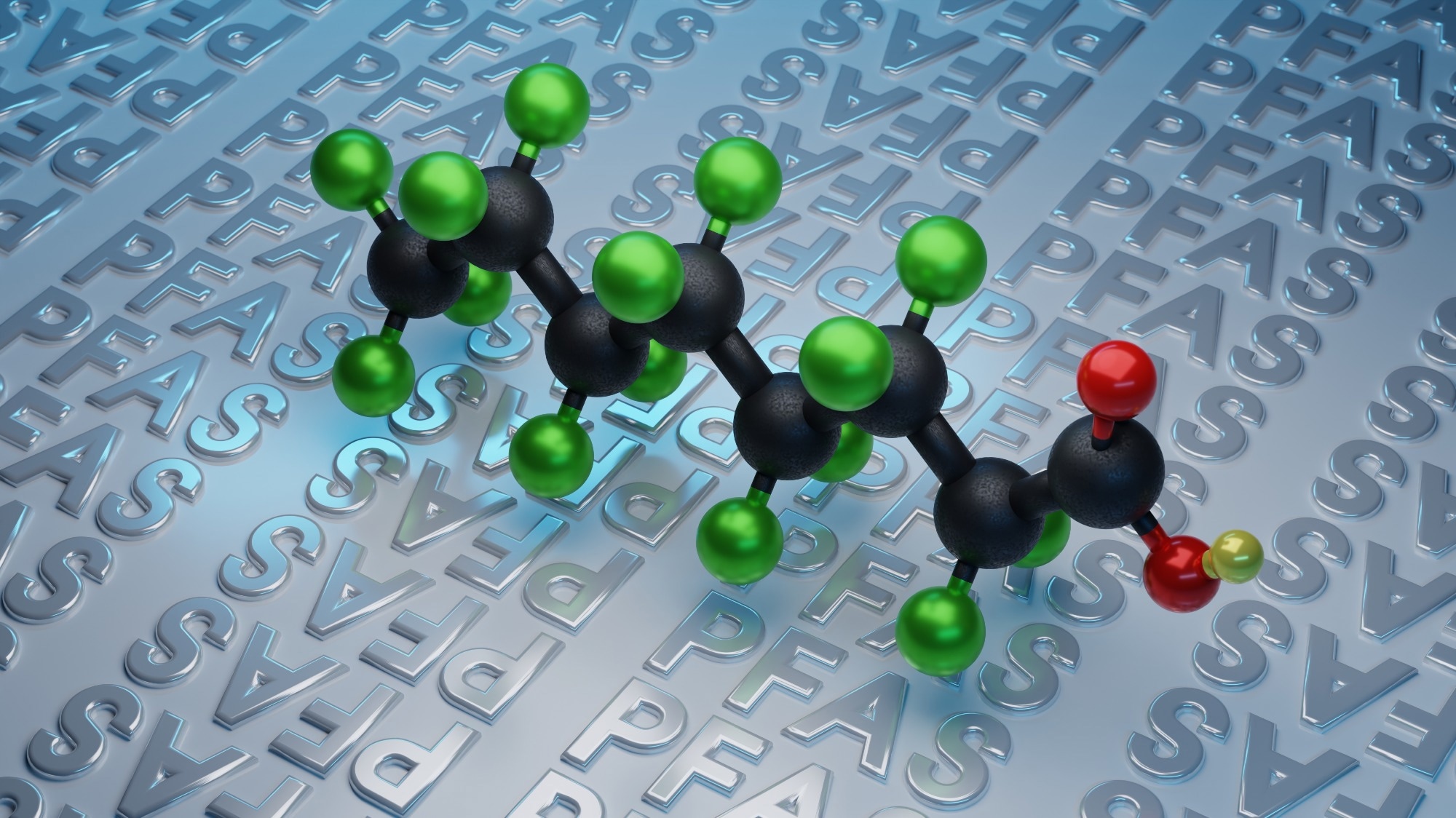Male fertility is dropping internationally due to elevated concentrations of endocrine-disrupting chemical substances (EDC), such as PFAS. These environmental pollutants affect hormone signaling, lowering testosterone levels while boosting estradiol levels. Human blood and seminal plasma contain PFAS, raising concerns about their possible harmful influence on male fertility. According to experimental investigations, perfluorooctanesulfonate (PFOS) exposure decreases spermiogenesis and maturation, altering testosterone levels. Understanding the systemic effects of environmental pollutants on general health is critical, particularly concerning cholesterol metabolism, liver function, and fat function.
 Study: Mixtures of per- and polyfluoroalkyl substances (PFAS) alter sperm methylation and long-term reprogramming of offspring liver and fat transcriptome. Image Credit: dba87 / Shutterstock
Study: Mixtures of per- and polyfluoroalkyl substances (PFAS) alter sperm methylation and long-term reprogramming of offspring liver and fat transcriptome. Image Credit: dba87 / Shutterstock
About the study
In the present study, researchers investigated the effects of preconception PFAS exposure in male mice on sperm epigenetics and offspring gene expression.
The researchers exposed C57BL/6 adult mice to a combination of five PFAS compounds in their drinking water for 18 weeks before collecting and analyzing them for deoxyribonucleic acid (DNA) methylation using reduced representation bisulfite sequencing (RRBS). PFOS, perfluorooctanoic acid (PFOA), perfluorononanoic acid (PFNA), tridecafluorohexane-1-sulfonic (PFHxS), and ammonium perfluoro(2-methyl-3-oxahexanoate) were the five PFAS chemicals that represented long-chain carboxylates and sulfonates, legacy alternatives, and short-chain emerging PFAS. Each of the five PFAS was dissolved in water at a concentration of 20.0 µg/L, yielding roughly 80 ng or 3.2 µg/kg per day.
The researchers divided the mice into two experimental groups at three to five months of age: vehicle control (n = 3) and PFAS mixture exposure (n = 4). They fed mice a high-fat diet that mimicked Western-style diets (40% fat, 2% cholesterol) for one week before administering PFAS. They compared genome-level methylation on epidydimal sperms by Illumina murine methylation arrays and RRBS, finding good agreement between both approaches. To compare transcriptome alterations between the treatment group and controls, they measured gene expression using ribonucleic acid (RNA) sequences in eight-week-old animals born to unexposed mothers.
Researchers conducted a follow-up study on adult male mice exposed to PFAS to investigate the intergenerational effects on their progeny. They collected caudal epididymal sperm and DNA from exposed and control animals, then used enzyme-linked immunosorbent assays (ELISA) to evaluate testosterone levels. They measured PFAS concentrations in the plasma, testes, and liver of F0 male mice. They found PFAS-induced differential methylated regions (DMRs) using general estimated equations (GEE) and Infinium mouse methylation-bead chip arrays. They also conducted feature-specific enrichment analysis of genic and CpG features utilizing PFAS-induced sperm DMRs and functional enrichment analysis on DMRs within 1,500 bp of transcription start sites or inside the gene body.
Results
PFAS mixtures produced 83 (Illumina) and 2,861 (RRBS) sperm differentially methylated regions. Functional enrichment demonstrated that PFAS-inflicted sperm DMR sites were related to developmental and behavioral processes in RRBS, whereas Illumina-identified DMRs were associated with cell signaling and lipid metabolism. PFAS mixes resulted in 53 and 40 differentially expressed genes (DEGs) among fat and liver cells in males and 31 and nine DEGs among female animals, respectively. Functional DEG enrichment indicated changes in cholesterol metabolic pathways, mitotic cellular cycle control in hepatic cells, and myeloid leukocytic migrations in male offspring's fat. In contrast, fat influenced carbohydrate metabolism and erythrocyte development among female offspring.
Exposure to PFAS caused a methylation shift in 2,861 sperm DMRs (greater than 5.0%), with 63% hypermethylated and 37% hypomethylated. Out of 2,861 DMRs, researchers found 1,970 distinct genes, with some of the most enriched functional keywords being neuron projection development, cell morphogenesis, head development, behavior, and wingless-related integration site (Wnt) signaling. PFAS exposure resulted in 83 sperm DMRs (≥2 CpGs per area, >5% methylation change) compared to the control group, with 12,772 CpG clusters identified from over 285,000 CpGs.
Researchers discovered 40 and nine DEGs in the livers of male and female offspring, respectively. Male livers demonstrated functional enrichment in cholesterol metabolic activities, xenobiotic reactions, small-molecule biosynthetic processes, and positive mitotic cell cycle control. Cholesterol concentrations were higher in PFAS-sired fathers than in controls. Male mice were likely to have myeloid leukocyte migration, muscle contraction, extracellular signal-regulated kinase 1/2 (ERK1/2) cascades, and calcium ion transport, and their female counterparts had erythrocyte formation, muscle contraction, carbohydrate catabolic processes, and phosphorus metabolic processes.
The study found that adult mice exposed to a combination of historical and new PFAS compounds have abnormal sperm methylation, impacting genes involved in Wnt signaling, neurodevelopment, and lipid metabolism. The offspring of PFAS-exposed men demonstrated alterations in gene expression in the liver and adipose tissue. PFAS accumulates in the testes and could influence the phenotype of future generations. PFAS presence raises concerns regarding its effect on epigenetic patterns during spermatogenesis, which may change sperm development and maturation.